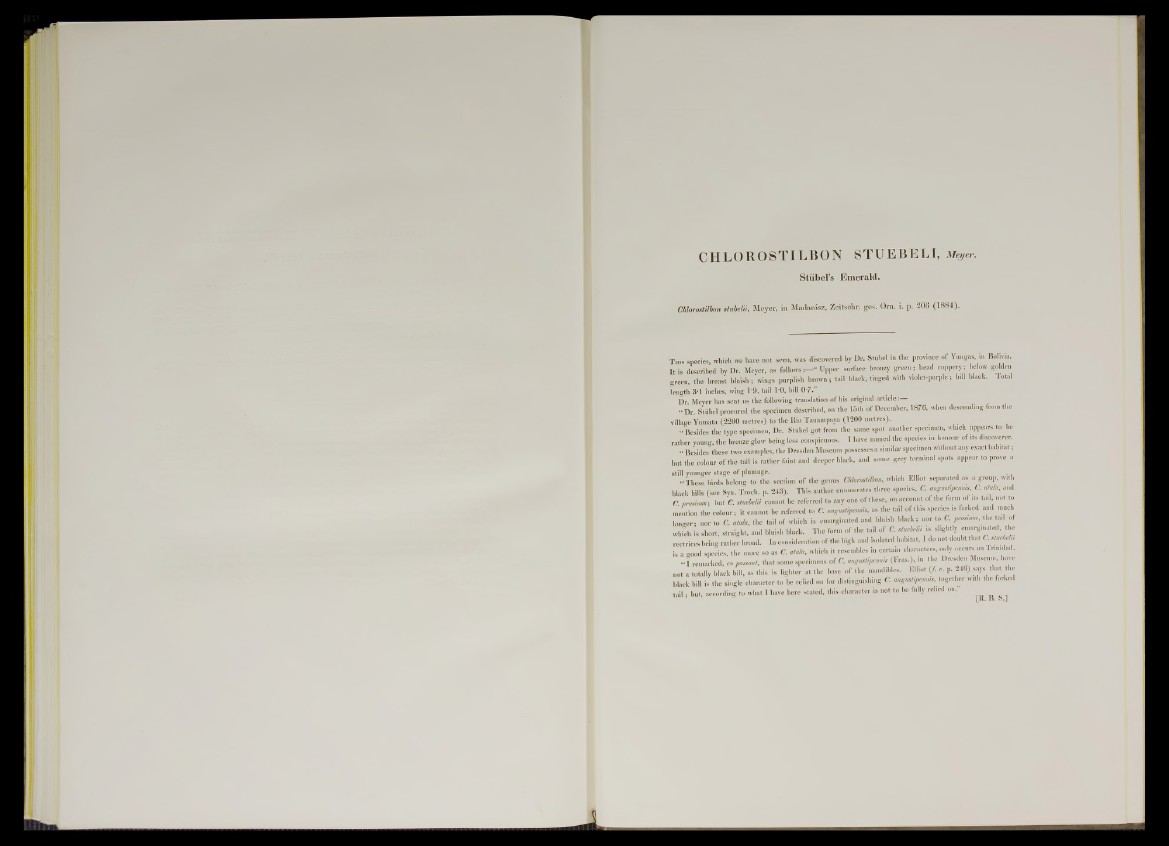
CHLOROSTILBON STUEBELI, Met/er.
Stübel’s Emerald.
Chlorostilbon stubelii, Meyer, in Madarasz, Zeitsehr. ges. Orn. i. p. 2 0 6 (1 8 8 4 ) .
T his species, which we have not seen, was discovered by Dr. Stübel in the province o f Ynngas, in Bolivia.
It is described by Dr. Meyer, as f o l l o w s S Upper surface bronzy green; head coppery; below goklen
green, the breast bluish; wings purplish brown; tail black, tinged with violet-parple; hill black. Total
length 3*1 inches, wing 1*9, tail 1*0, bill 0'7.”
Dr Meyer has sent us the following translation o f his original article:
Dr. Stiibel procured the specimen described, on the 15th of December, 1876, when descending from the
village Yumata (2200 metres) to the llio Tanampaya (1200 metres).
'•Besides the type specimen, Dr. Stübel got from the same spot another specimen, which appears to he
rather young, the bronze glow being less conspicuous. I have named the species in honour of its discoverer.
•' Besides these two examples, the Dresden Museum possesses a similar specimen without any exact habitat;
but the colour o f the tail is rather faint and deeper black, and some grey terminal spots appear to prove a
still younger stage of plumage. I
•'These birds belong to the section o f the genus Chhmtilbon, which Elliot separated as a group, with
black bills (see Syn. Troch. p. 243). This author enumerates three species, C. angustipenms, C. atala, and
C. » r am m ; hut C. staebelii cannot be referred to any one of these, on account of the form of its tad, not to
mention the colour; it cannot be referred to C. — as the tail of this spec.es ,s forked and much
longer; nor to C. atala, the tail of which is emarginated and bluish black; nor to C. prastnm, the tail of
which is short, straight, and bluish black. The form of the tail of C. staebelii Is slightly emarg,anted, the.
reetriees being rather broad. In consideration of the high and isolated habitat, I do not doubt that C stuebeln
is a good species, the more so as C. atala, which it resembles in certain characters, only occurs on Trinidad.
1 1 remarked, en passant, that some specimens of C. angustipennis (Fras.), in the Dresden Museum, have
not a totally black bill, as this is lighter at the base of the mandibles. Elhot (1. c. p. 246) says that the
black bill is the single el.aracter to be relied on for distinguishing C. aagustipenms, together with the forked
ta il; bat, according to what I have here stated, this character is not to he fully relied on. g ^